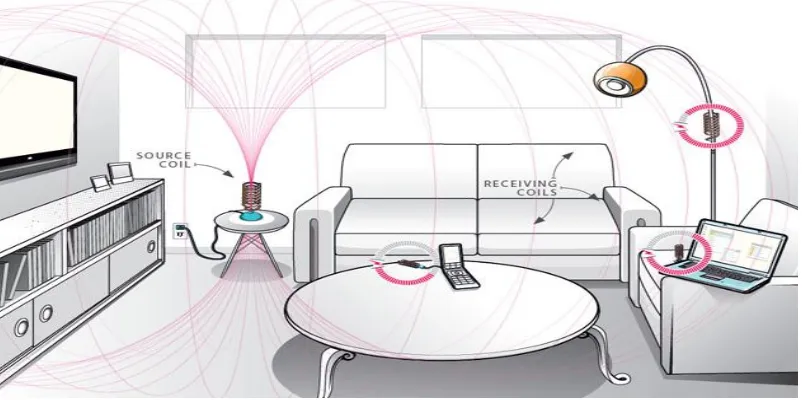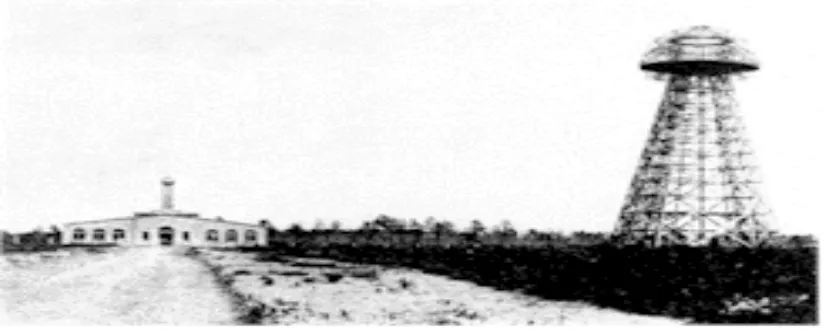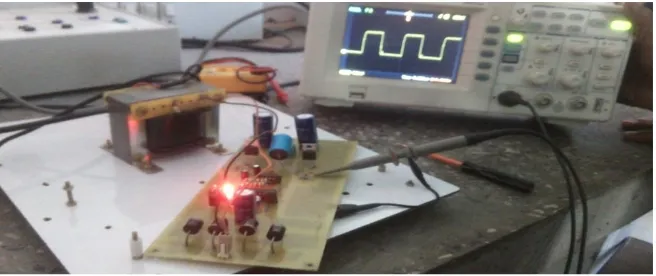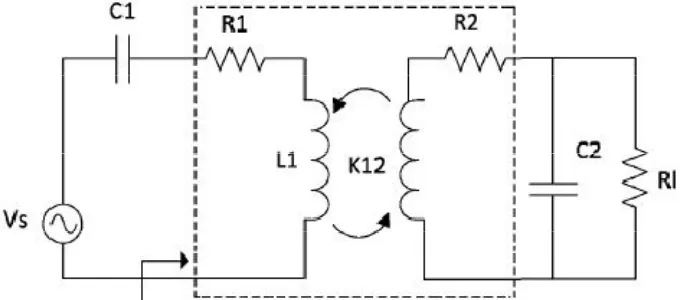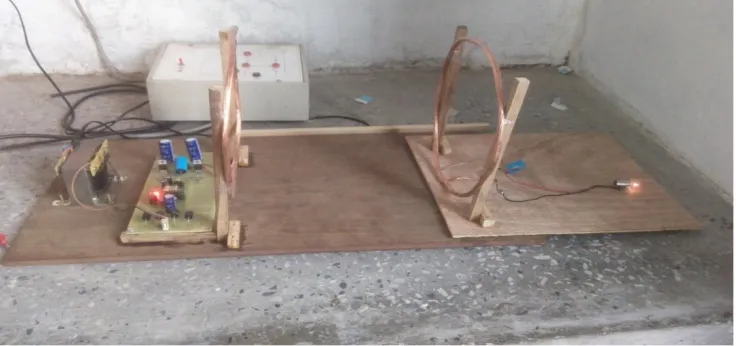An Innovative Design of Wireless Power
Transfer by High Frequency Resonant Coupling
Prashansa1, Aditya Duggal1, Manish Kumar Srivastava3
UG Student, Department of Electrical Engineering, S.S.E.T., S.H.I.A.T.S, Allahabad, Uttar Pradesh, India
Associate Professor, Department of Electrical Engineering, S.S.E.T. ., S.H.I.A.T.S, Allahabad, Uttar Pradesh, India
ABSTRACT: The main objective of this paper is to develop a concept of transferring power without use of any wires. The concept is based on low frequency to high frequency conversion. High frequency power is transmitted between inductor through air core. By using two self resonating coils, non-radiative power is transmitted over distances upto three times the radius of the inductor coils.
KEYWORDS: Resonant Inductive Coupling, High Resonant Frequency and Litz wire.
I. INTRODUCTION
Wireless power transfer is an emerging topic at global level research. Now days, WPT technology is becoming a need for the future. WPT is a technique for transferring power without using wires. Nikola Tesla proposed the concept of WPT more than a hundred years ago [1]. As more and more portable electronic devices and consumer electronics are developed and used, the need of WPT technology continues to grow.
Fig 1: Conceptual diagram showing the wireless power transfer in a room depicting a future without wires.
receiver self resonant coils [9]. It was also reported that magnetically coupled resonance WPT has several valuable advantages, such as efficient midrange power transfer, non-radiative, and nearly Omni-directional. It is certain that these properties will help to improve the performance of current WPT systems and will be utilized well for various wireless power transfer applications such as electric vehicles, consumer electronics, smart mobile devices, biomedical implants, robots, and so on [10].
The experiment is based on the transmission of a non-radiative energy from transmitter coil to the receiver coil using Resonant Inductive Coupling. The resonant inductive coupling technique is the principle method employed in short and mid range (1-2m) WPT systems.
II. RELATEDWORK
The concept of wireless power transfer is not new. Sir Nikola Tesla, used and demonstrated this technology of energy transmission in late 19th century. Many other scientists also contributed a lot in this field.
In 1890, Nikola Tesla patented his Tesla Coil, which was used for generating high frequency Alternating Currents.
In 1892, Maurice Hutin and Maurice Leblanc patented a wireless method of powering railroad trains using resonant
coils inductively coupled to a track wire at 3 kHz.
In 1893, Nikola Tesla demonstrated the illumination of vacuum bulbs without using wires for power transmission at
the World Columbian Exposition in Chicago. Nikola Tesla has been the pioneer in the field of wireless Transmission of electrical power.
In 1904, The Wardenclyffe tower was designed and constructed by Nikola Tesla mainly for wireless transmission of
electrical power. An airship ship motor of 0.1 horsepower is driven by transmitting power through space from a distance of at least 100 feet.
Fig 2: Wardenclyffe Tower Made By Nicola Tesla as the very first conducted experiment for the wireless power
transfer.
In 1995, Prof John Boys and Prof Grant Covic, of The University of Auckland in New Zealand, developed systems to
In November 2006, Marin Soljačić and other researchers at the Massachusetts Institute of Technologyapplied this near field behavior, well known in electromagnetic theory, the wireless power transmission concept based on strongly-coupled resonators.
In 2008, the Wireless Power Consortium was established to develop interoperable standards across manufacturers.
In August 2009, its Qi inductive power standard published which enables charging and powering of portable devices of
up to 5 watts over distances of 4 cm (1.6 inches).
In 2010, Ick-Jae Yoon demonstrated the power transfer efficiency of 40% at a distance of 0.25 (0.39 m at 195 MHz) in
the collinear configuration.
In 2011, Fei Zhang used strongly coupled electromagnetic resonator technology that was able to transmit electrical
energy over a much longer distance than traditional near field. He improved the performance of the present two-resonator[1][4][5][6].
III. . WORKING METHODOLGY
1. Block Diagram
Fig 3: Block diagram of the carried experiment for a designing WPT system that explains the low to high frequency switching.
The design of this experiment includes the conversion of low frequency supply of 50 Hz to high frequency AC supply of 40 kHz. Then the converted supply is fed to the transmitter coil which is tuned to the same resonating frequency as that of the receiver coil. A high frequency oscillating current is induced in the receiver coil which is kept at a maximum distance of 35cm.The driving circuit for high frequency switching is based on the push-pull concept. The transmitter and receiver coils are made up of multi-strands litz wire of radius of 11cms and 15 turns.
2. Resonant Inductive Coupling
Resonant inductive coupling or electro-dynamic induction is the near field wireless transmission of electrical energy between two magnetically coupled coils that are part of resonant circuits tuned to resonate at the same frequency. This process occurs in a resonant transformer, an electrical component which consists of two high Q coils wound on the same core with capacitors connected across the windings to make two coupled LC circuits. Resonant transformers are widely used in radio circuits as band-pass filters, and in switching power supplies. Resonant inductive coupling is also being used in wireless power systems. Here the two LC circuits are in different devices; a transmitter coil in one device transmits electric power across an intervening space to a resonant receiver coil in another device. This technology is being developed for powering and charging portable devices such as cell phones and tablet computers at a distance, without being tethered to an outlet.
Resonant transfer works by making a coil ring with an oscillating current. This generates an oscillating magnetic field. Because the coil is highly resonant, any energy placed in the coil dies away relatively slowly over very many cycles; but if a second coil is brought near it, the coil can pick up most of the energy before it is lost, even if it is at some distance. The fields used are predominately non-radiative, near fields (sometimes called evanescent waves), as all hardware is kept well within the 1/4 wavelength distance they radiate little energy from the transmitter to infinity [8] [9].
Fig 5: Equivalent circuit of Resonant Inductive Coupling or Electro-dynamic induction applied in the carried out experiment.
Resonance occurs when the voltage and current at the input terminals are in phase. This corresponds to a purely real admittance, so that the necessary condition is given by;
ωC – 1/ωL = 0.
The resonant condition may be achieved by adjusting L, C, or ω. Keeping L and C constant, the resonant frequency ωo
is given by:
Q factor of the coils can be calculated using this equation,
The Q factor of the coils used in the experiment is 350.71
The merit of efficiency is given by,
where Q1 and Q2 are the quality factor of both the coils.
And the maximum achievable efficiency is,
Because Q can be very high, even when low power is fed into the transmitter coil, a relatively intense field builds up
over multiple cycles, which increases the power that can be received—at resonance far more power is in the oscillating field than what is being fed into the coil, and the receiver coil receives a percentage of that [5][6][11][12].
IV. RESULT
The high frequency electrical energy having a power of 15W is transferred wirelessly from the transmitter coil to the receiver coil by the use of Resonant Inductive Coupling at a distance of 35 cm with an efficiency of 82.8%.
Fig 6: Designed model of the carried out experiment, the distance between the transmitter and the receiver coils was measured i.e. 35 cms with an efficiency of 82.8%.
Advantages
Implementation of this design for future electrification will bring a revolution in power distribution systems. Following points will justify the above statement.
1. Highly resonant strong coupling provides high efficiency over distance.
2. The power can be delivered in any direction i.e., Omni-directional.
3. Non-Radiative Energy Transfer is Safe for the entire Ecosystem.
4. Can reduce the manpower in installation distribution system in the hilly areas as well as in the plain areas. As
5. Transmission of power to remote areas such as islands, army bases, high altitude peaks, etc. is possible.
6. No need for meter rooms and electrical closets.
7. Reduction of e-waste by eliminating the need for power cords
V. CONCLUSION
The transmission of power without wires is not a theory or a mere possibility, it’s now a reality. The electrical energy can be economically transmitted wirelessly to any terrestrial location. In spite of high initial cost, WPT is economically viable with lower losses. It is proposed that at a Q factor of 350.7 of both the resonating coils, the transmission of power without wire can be successfully done at a distance of 35-40 cms.
Global warming and pollution are one of the most challenging hurdles for the future era. Global warming will be having a disastrous impact on this earth by 2050. So, to reduce the risk of grid failure, over-heating of conductors, wire losses, etc. it can be concluded that the power distribution system’s future will be dependent entirely on wireless power transfer.
VI. FUTURE WORK
It is suggested that, increasing the Q factor of the resonating coils can increase the efficiency of power transfer. Resonators having a Q factor of 1000 can transmit power up to 9 times the radius of the coil. In future, this experiment can result in the efficient power transfer wirelessly up to several kilometres in space with higher Q-factor and by increasing the diameters of the resonators. This technology will be very feasible in hilly areas and will improve the distribution system. Eliminating wires can reduce the conductor cost and prevent the wastage of land. Implementation of WPT technology will reduce the overhead wire congestion in local areas and also diminish the risk of short circuit. WPT can be result in improvement of the losses in present distribution system. There may be many aspects needed to be investigated for an improved WPT system.
REFERENCES
[1] N. Tesla, U.S. Patent 1,119,732 (1914)
[2] A. Kurs, Power Transfer Through Strongly Coupled Resonance, Masters of Science thesis, MIT, Sep, 2007.
[3] André Kurs, Aristeidis Karalis et al, “Wireless Power Transfer via Strongly Coupled Magnetic Resonances,” Science, vol. 317, no. 5834, pp. 83-86, July, 2007.
[4] Website: www.ijirset.com/upload/2014/august/30_Wireless.pdf [5] Website: en.wikipedia.org/wiki/Wireless power
[6] Website: en.wikipedia.org/wiki/Resonant_inductive_coupling
[7] Sample, A. P.; Meyer, A. & Smith, J. R. (2010). Analysis, experimental results, and range adaption of magnetically coupled resonators for wireless power transfer, IEEETransactions on Industrial Electronics, Vol.58, No. 2, 2010, pp. 544–554, ISSN 0036-8075.
[8] Karalis, A.; Joannopoulos, J. D. & Soljacic, M. (2008). Efficient wireless non-radiative mid-range energy transfer, Annals of Physics, 323, 2008, pp. 34–48, ISSN 0003-4916.
[9] Hamam, R. E.; Karalis, A.; Joannopoulos, J. D. & Soljacic, M. (2009). Efficient weakly-radiative wireless energy transfer: an EIT-like approach, Annals of Physics, 324, 2009, pp. 1783–1795, ISSN 0003-4916
[10] MID RANGE MAGNETICALLY-COUPLED RESONANT CIRCUIT WIRELESS POWER TRANSFER” by VARUN NAGOORKAR, The
University of Texas at Tyler, May 2014
[11] Md. Saifuddin et al. International Journal of Engineering Research and Applications www.ijera.com ISSN: 2248-9622, Vol. 4, Issue 10(Version 6), October 2014, pp.66-96
BIOGRAPHY
1. Prashansa, Student, Department of Electrical Engineering, S.S.E.T., Sam Higginbottom
Institute of Agriculture, Technology & Sciences, Allahabad, Uttar Pradesh, India, PIN-211007. She has completed her Bachelors of Technology in Electrical & Electronics Engineering in the year of 2015. She belongs to Muzaffarpur, Bihar, India. Her areas of interest are Power Systems & Renewable Energy.
2. Aditya Duggal, Student, Department of Electrical Engineering, S.S.E.T., Sam Higginbottom
Institute of Agriculture, Technology & Sciences, Allahabad, Uttar Pradesh, India, PIN-211007. He has completed his Bachelors of Technology in Electrical & Electronics Engineering in the year of 2015. He belongs to Allahabad, Uttar Pradesh, India. His areas of interest are Power Generation, Non-Conventional Energy Sources & Energy systems.
3. Manish Kumar Srivastava, Ex-Director of MVIET& AIET, Ex-Head and Associate Professor,
